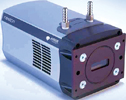Spectroscopic camera that uses electron multiplying CCD technology
February 2007
Sensors & Transducers

Andor Technology, a world-leading supplier of specialised cameras and spectrographs for scientific applications, recently released the Newton which is the first spectroscopic camera to use electron multiplying CCD (EMCCD) technology. These sensors are manufactured using standard CCD fabrication methods but the unique feature is an electron multiplying structure that is inserted between the end of the shift register and the output amplifier. Similar devices have been patented by both E2V and Texas Instruments. Transferring electrons undergo impact ionisation which as a result generates new electrons and thereby providing multiplication or gain. In many cases this does away with the need to use intensified CCD devices and the EMCCD has been hailed as the new ICCD. What one has in effect with the EMCCD is the equivalent of a solid state image intensifier which does not have the disadvantage of a limited MTBF.
The top-of-the range Newton has a 2048 x 512 array of 13,5 μm pixels and thermoelectric cooling down to -100°C which results in negligible dark current. Versions are also available with other array formats such as 1600 x 200 or 1600 x 400 using 16 μm pixels. This high resolution spectroscopic sensor combined with Andor's low noise electronics delivers quantum efficiencies of up to 95% with multiMHz read out and USB connectivity. The cameras can be purchased with coatings and windows that maximise performance in various spectral regions, such as the visible, 250 nm or 350 nm. The detector itself is sensitive in the 200 to 1100 nm range.
The Newton camera can be interfaced to most standard spectrographs and other standard adaptors include the well-known C-mount and Nikon F-mount. The camera also possesses software selectable outputs for either high responsivity mode (low noise) or high signal mode.
For operation, the Newton requires one of Andor's two software options, these being the Andor MCD or the Andor-SDK-CCD. The former provides rich functionality for data acquisition and processing, while with the latter a DLL driver and software development kit allows individual applications to be created by the user. Andor software is Windows-based and supports all versions from Windows 95 onwards. To handle data transfer rates of 3 MHz a powerful computer with at least 1 GB RAM, 32 MB free hard disk space and preferably Windows 2000 or later is required.
Further reading:
Miniature inductive sensors
ifm - South Africa
Sensors & Transducers
The inductive IY/IZ type sensors from ifm are used in various industrial areas where space is limited.
Read more...
The expanding role of 3D cameras in industrial quality control
TANDM Technologies
Sensors & Transducers
Across factory floors, warehouses, mines and research centres worldwide, computer vision paired with 3D camera technology is revolutionising quality control.
Read more...
PDS implementation on mines
Sensors & Transducers
Level 9 vehicle intervention for collision avoidance has been mandatory on South African mines since 2022, yet the effective roll-out of proximity detection systems remains slower than expected. This is not due to the technical limitations of integration but to operational readiness on site.
Read more...
Monitoring analogue process values
ifm - South Africa
Sensors & Transducers
Everywhere in industry, electronic sensors are used to detect process values such as temperature, pressure or flow. Process value monitoring often takes place directly in the sensor.
Read more...
Protecting buildings’ embodied carbon with retrofitted systems
Schneider Electric South Africa
Sensors & Transducers
The World Economic Forum has said that around 80% of the buildings in existence will still be around in 2050; it is therefore essential that in order to combat climate change we retrofit them for energy efficiency.
Read more...
Listening for damage to wind turbines
Sensors & Transducers
The Fraunhofer Institute for Integrated Circuits, working in concert with the Fraunhofer Institute for Wind Energy Systems, has developed a solution that can be used to identify cracks and breakage inside wind turbine blades remotely at an early stage.
Read more...
Enhancing gold leaching efficiency
Endress+Hauser South Africa
Sensors & Transducers
Endress+Hauser offers a range of advanced technologies designed to enhance the stability and accuracy of pH and dissolved oxygen measurements on gold processing plants.
Read more...
Powering safer mining with PDS
Sensors & Transducers
With the mining industry under increasing pressure to prioritise safety without compromising productivity, Booyco Electronics is pushing the boundaries of Proximity Detection System and Collision Avoidance System technology across both underground and surface operations.
Read more...
The car of the future listens
Sensors & Transducers
The perception of external sounds in cars has been lacking, even in automated driving. That is why Fraunhofer IDMT-HSA is researching the integration of acoustic sensor technology in its KI4BoardNet project with the Hearing Car.
Read more...
Telco Sensors for blocked or empty chute detection
Sensors & Transducers
In most industries there is a problem with photoelectric sensors as highly contaminated environments make it difficult to operate and sense reliably. Telco Sensors overcomes this through its powerful high-performance infrared sensors that ensure penetration of harsh pollution to guarantee reliable detection.
Read more...


